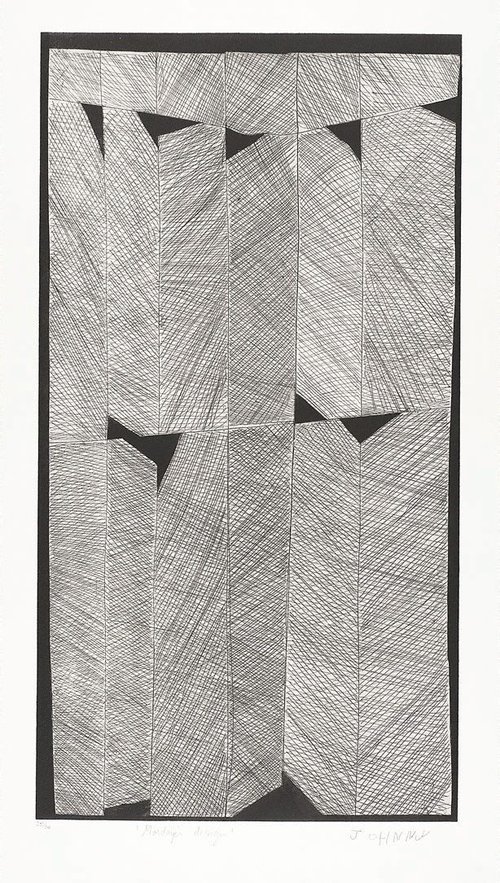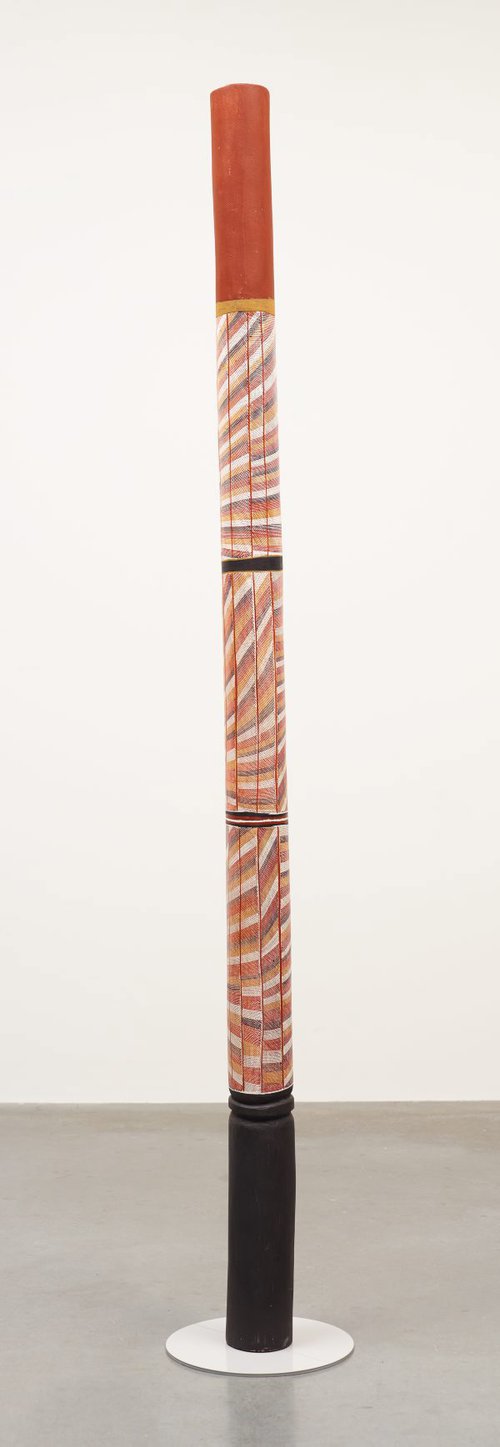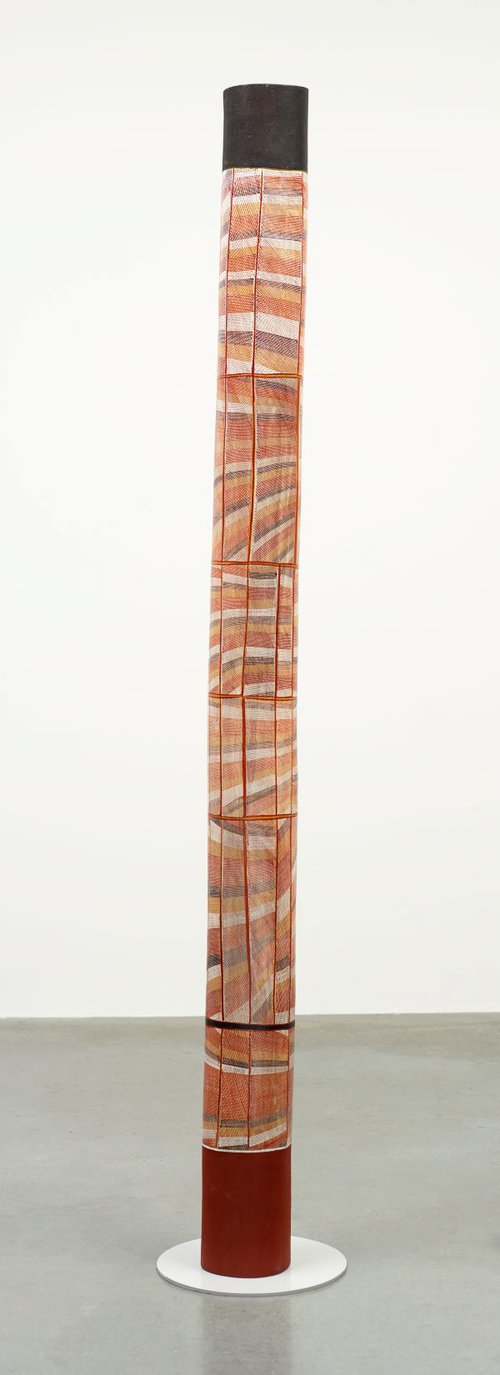Title
Mardayin ceremony
2000
Artist
-
Details
- Other Title
- Untitled
- Places where the work was made
-
Western Arnhem Land
→
Northern Territory
→
Australia
Milmilngkan → Western Arnhem Land → Northern Territory → Australia
- Date
- 2000
- Media category
- Bark painting
- Materials used
- natural pigments on eucalyptus bark
- Dimensions
- 170.0 x 78.0 cm (irreg.)
- Signature & date
Not signed. Not dated.
- Credit
- Don Mitchell Bequest Fund 2000
- Location
- Not on display
- Accession number
- 538.2000
- Copyright
- © John Mawurndjul, Maningrida Arts and Culture/Copyright Agency
- Artist information
-
 John Mawurndjul
John Mawurndjul
Works in the collection
- Share
-
-
About
John Mawurndjul is one of the most experimental bark painters in Arnhem Land. Mawurndjul grew up in his country near Mumeka on the Mann River. He lived for a considerable time in the newly established Aboriginal town of Maningrida in the 1960s, but returned to Mumeka from 1972. Today he moves regularly between Maningrida and his outstation at Milmilngkan, south of Maningrida. He was taught to paint by his father, Anchor Kulunba, his brother Jimmy Njiminjuma and his uncle Peter Marralwanga. Mawurndjul's early work of the late 1970s reveals his meticulous attention to detail and very fine rarrk (crosshatching) technique.
Many of his early works are relatively small images of the rainbow serpent Ngalyod in snake-like form, or of the yawkyawk, mermaid-like creatures that were devoured by Ngalyod in Mawurndjul's clan lands. However, in the late 1980s Mawurndjul began to produce larger paintings of this subject, which evoked the powerful twists and turns of the body of Ngalyod. The iridescent rarrk across Ngalyod's body captures the almost electric, radiating power of this being. In other paintings, Mawurndjul experimented with complex interactions of figurative forms, particularly in depictions of Ngalyod involved in the act of biting or swallowing the yawkyawk. Sometimes Mawurndjul shows the dismembered bodies, and at other times they may be merging together. In essence, the imagery of the rainbow serpent swallowing these other beings is a reference to site creation, of the yawkyawk joining with Ngalyod inside the earth and investing it with their everlasting power.
More recently, Mawurndjul has emphasised the geometric aesthetic in Kuninjku painting. He has produced works that comprise grids of crosshatching with circles representing waterholes enmeshed in the grid. These paintings relate to Mardayin body paintings, and focus attention upon the abstract representation of features of the associated landscape. In the context of the Mardayin ceremony, these geometric body designs are said to physically connect initiates to the sacred power of the ancestral beings who made their clan lands. Mawurndjul has said that he is not simply reproducing ceremonial designs in works such as 'Mardayin ceremony', 2000, but that he is also creating new forms of patterning and composition. Mawurndjul has travelled the world with his art, and studied collections of early bark painting in cities as far afield as Paris. Through his art, Mawurndjul draws upon and extends Kuninjku traditions to promote a wider understanding of his culture.
Luke Taylor in 'Tradition today: Indigenous art in Australia', Art Gallery of New South Wales, Sydney, 2004
© Art Gallery of New South Wales
-
Places
Where the work was made
Western Arnhem Land
-
Exhibition history
Shown in 9 exhibitions
Aboriginal bark paintings, sculptures & hollow logs from Maningrida and Yirrkala Arnhemland, Annandale Galleries, Annandale, 13 Sep 2000–14 Oct 2000
Crossing country: the alchemy of Western Arnhem Land art, Art Gallery of New South Wales, Sydney, 24 Sep 2004–12 Dec 2004
rarrk – John Mawurndjul: Zeitreise in Nordaustralien, Museum Tinguely, Basel, 21 Sep 2005–29 Jan 2006
rarrk – John Mawurndjul: Zeitreise in Nordaustralien, Sprengel Museum Hannover, Germany, 19 Feb 2006–06 Jun 2006
Mumeka to Milmilgkan, Drill Hall Gallery, Australian National University, Canberra, 02 Nov 2006–15 Dec 2006
One sun, one moon, Art Gallery of New South Wales, Sydney, 03 Jul 2007–02 Dec 2007
Country Culture Community (2008-09), Art Gallery of New South Wales, Sydney, 12 Nov 2008–19 Apr 2009
The Dreamers (2009-10), Art Gallery of New South Wales, Sydney, 09 May 2009–15 Aug 2010
John Mawurndjul and Gulumbu Yunupingu: Earth and Sky, TarraWarra Museum of Art, Healesville, 28 Mar 2015–08 Jun 2015
John Mawurndjul: I am the old and the new, Museum of Contemporary Art, Australia, 06 Jul 2018–23 Sep 2018
John Mawurndjul: I am the old and the new, Art Gallery of South Australia, Adelaide, 11 Oct 2018–28 Jan 2019
-
Bibliography
Referenced in 8 publications
-
Edmund Capon AM, OBE, Art Gallery of New South Wales: highlights from the collection, Sydney, 2008, 30, 31 (colour illus.).
-
Guido Magnaguagno (Director) and Bernhard Lüthi (Curator), "rarrk" John Mawurndjul: journey through time in northern Australia, Basel, 2005, 133 (colour illus.), 228.
-
Hetti Perkins and Margie West, One sun one moon: Aboriginal art in Australia, ‘John Mawurndjul in conversation’, pg. 93-97, Sydney, 2007, 92 (colour illus.).
-
Hetti Perkins, Crossing country: the alchemy of western Arnhem Land art, Sydney, 2004, 94 (colour illus.), 226.
-
Hetti Perkins, Earth and sky: John Mawurndul and Gulumbu Yunupingu, 'Earth: John Mawurndjul: works', pg. 8-33, Healesville, 2015, 8 (colour illus.), 9 (colour illus., detail).
-
Hetti Perkins, Art + soul: a journey into the world of Aboriginal art, 'Home + away', pg. 1-86, Carlton, 2010, 49 (colour illus.), 279.
-
Public Programmes Department, Art Gallery of New South Wales, Crossing country: the alchemy of western Arnhem Land art, 'Site and subject', Sydney, 2004, (colour illus.).
-
Luke Taylor, Tradition today: Indigenous art in Australia, 'John Mawurndjul', pg. 82, Sydney, 2004, 82, 83 (colour illus.).
-




